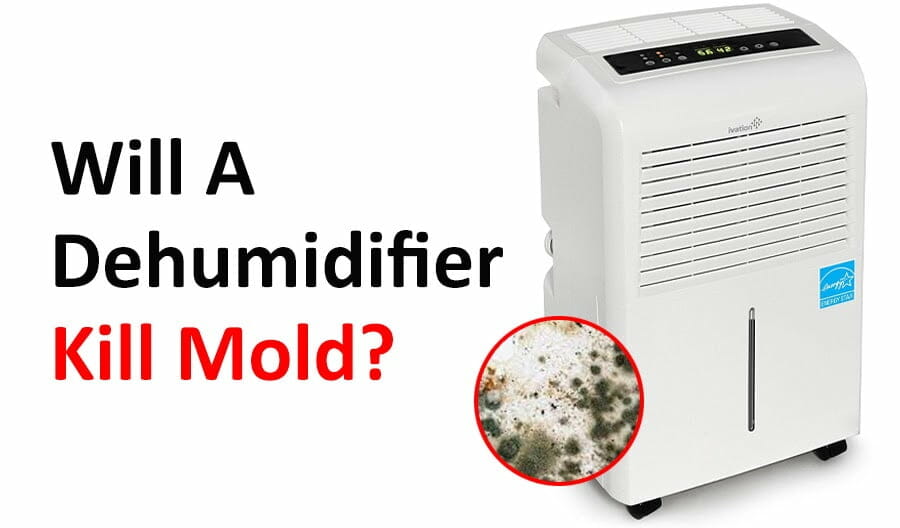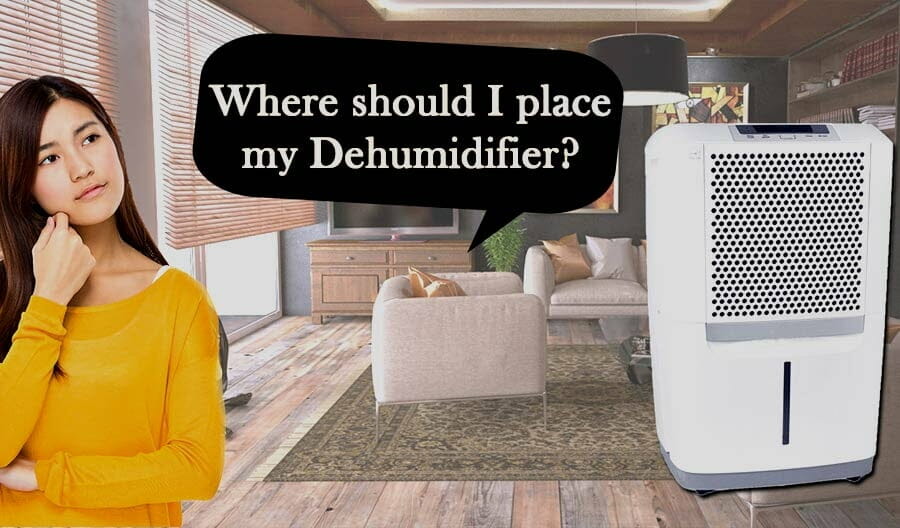Can a high-quality dehumidifier effectively remove excess moisture and airborne pollutants, thereby improving respiratory well-being and possibly getting rid of mold? Is it considered safe to inhabit a house or occupy a room plagued with black mold when a dehumidifier is in use?
A dehumidifier does not kill mold but it can prevent further growth by reducing humidity. If you have mold in a room, the best and recommended action is to have it removed. Dry mold particles may still break off and poison the air even with a humidifier depriving the mold of vital moisture it needs to spread.
How Does Dehumidifier Really Work for Mold?
A modern dehumidifier has a simple mechanism made to remove excess moisture from the air. It works by sucking warm air, cooling it using refrigeration coils, and retaining moisture in an internal tank as water.
By sucking warm humid air and releasing cool dry air into a room, the humidifier essentially makes it harder for most indoor molds like Stachybotrys (black mold) to stay active. Mold needs moisture and warmth to thrive and establish new colonies by spreading its spores.
However, depriving the mold of the moisture and other conditions it needs does not kill it but puts it into a non-active or dormant stage. This means the mold can continue growing and releasing poisonous dust-like spores into a room when humidity increases when you turn off the dehumidifier. At the same time, dry dormant spores can still poison the air even when a humidifier is actively making the air drier.
In summary a humidifier:
- Sucks warm humid air and releases cool dry air
- Can prevent mold if it did not exist in the first place but cannot kill it
- Mold goes into a dormant state when there is little moisture and warmth
- You can still get mold poisoning even with a humidifier working to thin the air
Use a humidifier to prevent excess humidity and stop existing mold from spreading but not as a mold killer.

Will A Dehumidifier Solve Mold Problems?
Humidifiers are good for preventing mold in a room that does not have a mold problem or one that had mold removed recently. They cannot help solve mold problems because of the following reasons:
Dehumidifiers Do Not Kill Existing Mold
By design, a dehumidifier is made to reduce the amount of moisture in the room. However, dehumidifiers cannot kill existing mold even when they suck all the moisture.
Most indoor mold varieties can survive for months without moisture by going into an inactive state where they don’t actively spread or grow new spores. This means you can get into contact with toxic, dormant mold either by touching or breathing dry spores present in the air. At the same time, dormant mold will still produce a certain smell and also destroy the surfaces it’s growing on.
Mold Spores Can Spread from Other Rooms
Most dehumidifiers suck moisture in a single room in the house meaning mold can still thrive in adjacent rooms, ceilings, and inside drywall. This means you can still get air contamination from mold spores coming from active mold in other parts of your house. Dust-like mold spores can also spread to air-purified rooms through AC ducts, doors, and other openings.
Mold Can Grow When the Dehumidifier Is Off
If you are like most people, you probably turn on the dehumidifier when you are at home, when you go to sleep or when you feel uncomfortable in a room. Doing this temporarily deprives mold of the moisture it needs to continue growing.
Turning the dehumidifier off even for a few hours in a day can provide existing hidden mold the moisture it needs to stay alive and continue releasing poisonous spores into the air and other surfaces such as carpets, beddings, curtains, furniture, etc.
Note: You should have an expert inspect your house for mold and remove it if you want to permanently solve mold problems instead of relying on a dehumidifier or purifier. Getting rid of mold can prevent it from staying dormant and spreading to other areas of your house when humidity increases.
Mold inspectors can also help identify the source of moisture such as a broken water pipe, leak, or water damage so that you can have it fixed as a preventive measure after the mold has been removed. Use our free tool to find top-rated mold inspectors in your location today by following these steps:
- Scroll to the top of the page and enter your Zipcode
- Answer questions about what you want to be done
- The information you enter will be forwarded to three local mold inspectors. They will send you a price estimate for the job and some friendly advice
IMPORTANT: There is no obligation to hire. This is a free tool and service to be used at your pleasure
Some mold removal services may also offer to provide free mold inspection and only charge for removal and remediation services.
Can A Dehumidifier Remove Mold Spores?
No, a dehumidifier cannot remove mold spores from the air or any surfaces in your home. Dehumidifiers lessen the chance of condensation forming on surfaces thus preventing mold. Dehumidifiers may make the air thinner and easier to breathe but they cannot get rid of floating mold spores.
You can tell there are mold spores in the air if you start sneezing, coughing, or having difficulty breathing when you get into a room even if the dehumidifier is on. Mold spores may also settle into surfaces such as furniture and bedding and get into your lungs through direct contact.
Does A Dehumidifier Kill Black Mold?
No, dehumidifiers are not designed to kill black mold or any other toxic substances in the air. They can prevent black mold from spreading by depriving it of vital moisture but they can’t kill it. Black mold (Stachybotrys chartarum) is one of the resilient toxic indoor mold species that can survive for years with little to no moisture or cellulose to feed on. It goes into an inactive state but still keeps on releasing toxic spores into the air throughout its dormancy.
If you find small spots of black mold in a room, you can clean it off immediately using vinegar or other recommended home remedies. However large patches or a musty earthy smell is a sign of a serious mold problem and should be inspected and removed professionally to prevent exposure and further spread.
How Long Does It Take for A Dehumidifier to Kill Mold?
Dehumidifiers can reduce the humidity required for some indoor molds to survive thus putting them into a dormant state or killing them. Some of the most common indoor molds like Stachybotrys, chartarum, aspergillus, and Alternaria can survive for several months or years in a room with little to no moisture by becoming dormant. This makes a dehumidifier an infective way to get rid of mold as compared to chemical removal or remediation.
Will A Dehumidifier Get Rid of Musty Smell?
Dehumidifiers cannot get rid of the musty, earthy smell that comes from mold spores in the air circulation because they do not do air purification. Dehumidifiers simply reduce the amount of moisture in a room thus reducing condensation and making the air drier. They are not designed to get rid of smells or odors. That said some modern, advanced dehumidifiers do double up as air purifiers.
Is A Dehumidifier Better for Mold Than an Air Purifier?
Both dehumidifiers and air purifiers are not effective solutions to mold problems. A dehumidifier can prevent mold but it’s useless for existing mold. Air purifiers on the other hand can get rid of some toxins and bad smells in the air but will not kill mold. Mold growing on surfaces and spreading its spores should be removed.
Where Is the Best Place to Put Dehumidifier So It Is Effective?
If you want to prevent condensation and prevent mold from spreading, you should ideally place your dehumidifier in a central place so that it can suck humid air from all directions. Avoid placing your dehumidifier near a window or door. Bigger dehumidifiers are also designed to be mounted in a special compartment so be sure to check the manufacturer’s installation guidelines.

FAQ's
Should I Turn Off My Dehumidifier in The Winter?
It’s advisable to turn off dehumidifiers in the winter if humidity and temperatures are very low. Leaving the dehumidifier on at low temperatures may also cause the coils to freeze and cause permanent damage. Ideally, dehumidifiers should be used in spring and early fall and turned off in winter.
Does A Dehumidifier Use A Lot of Electricity?
The amount of electricity used by a dehumidifier depends on its size and power rating. Small, modern portable dehumidifiers do not use a lot of electricity. However, you should turn your humidifier off when you don’t need it.
Should A Dehumidifier Run Constantly?
It is not advisable or necessary to run your dehumidifier constantly. Only turn your dehumidifier on when humidity rises above 50%. Modern smart dehumidifiers can also be set to automatically switch on or off depending on environmental measurements.






